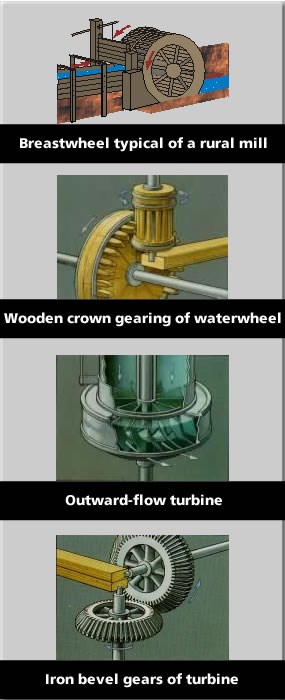|
Next: Mill Power Drives

National Park Service The use of water as a source of motive power dates at least to Greek and Roman civilizations. In ancient times and in the Middle Ages, waterpower seems to have been limited largely to irrigation and the grinding of grains for bread. In colonial America, waterwheels commonly provided power for sawing timber, fulling cloth, grinding grains, and making iron products. Until the second half of the 19th century, waterpower was the major mechanical power source in the United States. The principles behind waterpower are simple. Basically, a waterpower system taps the potential energy stored in water and turns it into kinetic energy by controlling its natural fall. Water is channeled out of a river at a certain height in a power canal and brought to a point where it is permitted to fall to a lower level. During its fall, it fills the buckets in a waterwheel, its weight driving the wheel around. Falling water also powers the more efficient turbine, driving it by pressure as well as weight. In the first turbines designed by Uriah Boyden and adapted by James B. Francis to power Lowell's mills, the water entered the wheel at its center and was directed outward by stationary vanes to turn another set of moving vanes. By 1858, 56 Boyden turbines (drawing at right), rated at 35 to 650 horsepower, helped drive Lowell's mills. In both the waterwheel and turbine, the power was transferred by gears to the mill's main power shaft or drive pulley. Source: Lowell National Historical Park Handbook 140
Next: Mill Power Drives
|
Last updated: February 26, 2015
